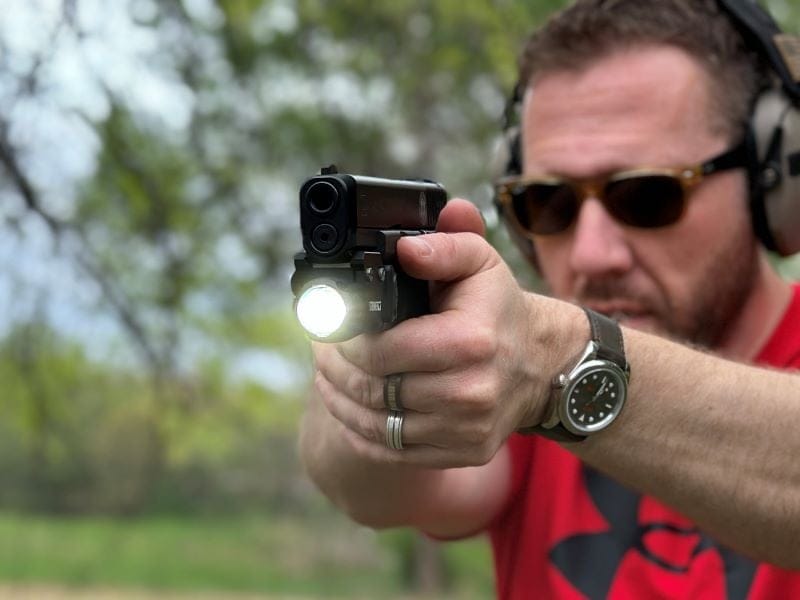We talk a lot about having a light on your weapon for those unexpected emergencies in low-light conditions. It’s easy to forget about a light or not see the need for one. This is partially because it is daylight when we are out and about. If it’s dark, we have plenty of light sources around us and so we get used to always having light. But you never know when you may be drawn away from a light source and find yourself in a situation where you don’t have time to find a light.

The second problem with shooting at night is people forget to use their lights when there is a sudden threat because they have not practiced that way. If you haven’t trained your body on what to do in those moments it will require a deliberate command from your brain. And brains don’t work very well when your body is in survival mode. In the law enforcement field, I see this time and time again. Training your body to function in an emergency is much harder than it sounds, and it takes lots of practice. I had an incident at work not long ago that reminded me of this.
A Rampage in the Dark
It was in the evening hours and the sun was still up when I got the call that a man was shooting at a deputy. The suspect had run from police earlier in the day. When the deputy tried to make a traffic stop, he took off. The suspect went into the ditch and jumped out of his car; he then began firing at the deputy’s car with an AR-15 rifle. He managed to blow out all the windows but thankfully missed the deputy.

This type of situation is hard to handle because you can’t see in the dark, but you also don’t want to hold a light when an armed criminal is hiding in the woods with a rifle. The helicopters had infrared, but the wooded area was so thick, it was making it hard for them to determine where he was.
The man made it to a home where he found a car with the keys in it. He pointed his gun at the homeowners as he jumped in and took off. A second pursuit ended with him wrecking for the second time and running into the woods again. The third time he tried to take a car didn’t go well for him either.
Danger in Low Light Conditions
By now everyone in the neighborhood knew there was an armed criminal on the loose. As the suspect walked up to his third car to steal it, the homeowners, who were armed, started yelling at him and called a deputy on the phone. Two deputies at a nearby intersection found him and the suspect rammed into one of their cars, pushing it off the road.
Both deputies got out of their cars and opened fire at the vehicle, hitting the suspect in the leg but not stopping him. After a lengthy pursuit with dozens of patrol cars, the suspect wrecked for the third time and ran on foot. This time, however, the hovering helicopters followed him and gave us his location. Within minutes dozens of law enforcement members surrounded him and took him into custody.

The deputies who shot at the vehicle never activated their lights either. So why have a light on your gun and not use it when shooting in the dark? Because the body was in survival mode and turning on a light wasn’t a learned habit. Every one of us out there that night performs countless hours on the range with many of them being in low-light conditions. But not enough to create muscle memory.
Training with Light
By the end of that night, we had three stolen/wrecked vehicles. He hit one patrol car and shootings took place in two separate locations. It was a miracle that no one was injured except the suspect in his leg. Incidents like these provide better insight and opportunities for learning than any type of training we could simulate on the range.
You just must be willing to learn from those opportunities and acknowledge areas that need improvement. Along with the lights, several deputies also failed to turn their red dots on. When the suspect crashed, he jumped from his car and took off, so everyone’s adrenaline was up, and they were not thinking about stopping and turning things on before they took off after him.

Conclusion
Having a light mounted on your gun may not always be an option. And there is no rule that says you can’t carry a gun without a light. But incidents do take place at all hours of the day. Even during the daytime, you could find yourself in a low-light area. But don’t stop at buying the light and mounting it on your gun. Practice, practice, practice. Train your body to activate the light before you shoot so your brain doesn’t need to give a special command each time.
For most self-defense applications, you could train to activate your light anytime you fire the weapon regardless of the light conditions. This would make it simple for your body to learn. There are lots of accessories for a handgun or rifle, but in my opinion, a light is one of the most important. If the time comes when you need to pull the trigger, you need to see exactly what you are shooting at.


